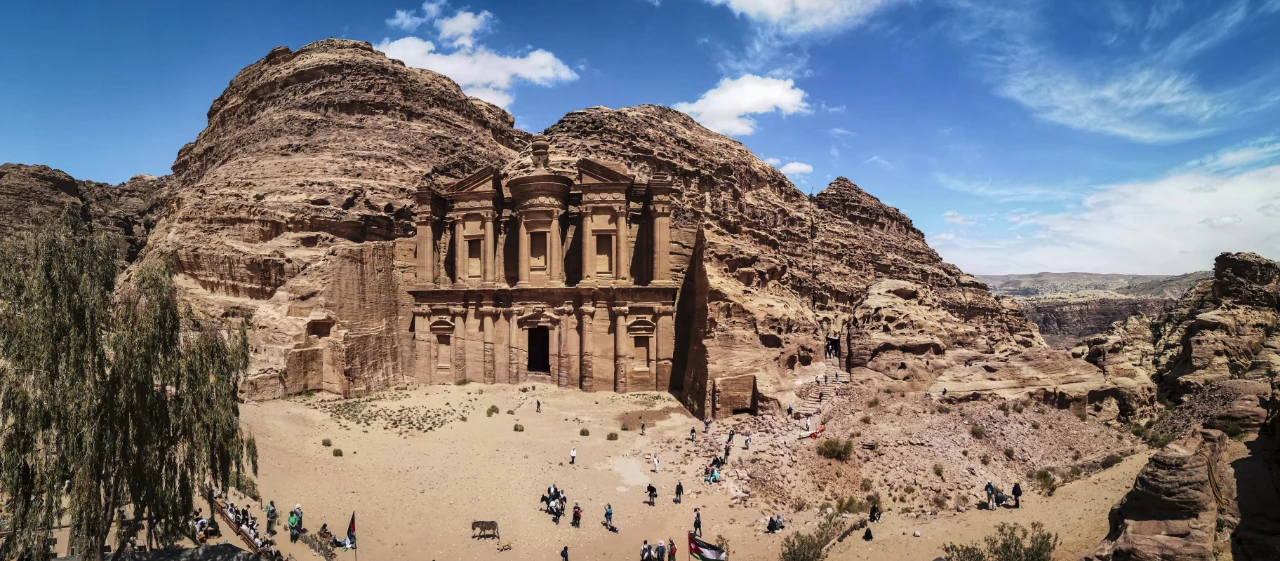Mystical Petra: Jordan’s Lost City in the Rocks
Carved into rose-colored cliffs and hidden in a desert valley, Petra is one of the world’s most awe-inspiring archaeological wonders. Known as the “Lost City”, this ancient Nabatean capital in southern Jordan feels less like a ruin and more like a secret whispered by stone and time.
Walking through its narrow canyon entrance, the Siq, and seeing the Treasury appear—towering and majestic—is a moment travelers never forget. Petra doesn’t just show its beauty; it reveals it, piece by piece, like a mystery being solved.
A City Carved by Hand, Preserved by Time
Petra was built over 2,000 years ago by the Nabateans, a nomadic Arab people who turned this isolated valley into a thriving trade hub. They carved temples, tombs, and homes directly into the sandstone cliffs, blending engineering, art, and spirituality in ways still admired today.
The most famous structure is Al-Khazneh, or the Treasury, with its towering columns and intricate façade. But Petra is vast—spreading over 60 square kilometers. Hike a little farther and you’ll find:
- The Monastery (Ad Deir), larger than the Treasury and just as impressive.
- The Royal Tombs, lined along the rock face like ancient guardians.
- The High Place of Sacrifice, where rituals were performed high above the city.
Each site tells a different part of the story, and the deeper you go, the more Petra seems to come alive.
The Magic of Arrival
The entrance to Petra is unlike any other. The Siq is a winding sandstone gorge, nearly a mile long, with towering walls that twist and narrow, playing with light and shadow.
As you walk, carvings, water channels, and weathered gods mark your way—hints of the city ahead. And then, just when you feel lost in the stone, it happens: the Treasury reveals itself at the end of the canyon like a vision from another world.
It’s not just what you see—it’s how you see it. Petra knows how to build suspense.
More Than Ruins
Petra wasn’t just temples and tombs. It was a full-fledged city, complete with:
- A Roman-style theater that seated over 6,000.
- A colonnaded street and public plazas.
- Sophisticated water systems that turned a desert into a place of life.
The Nabateans were masterful engineers, traders, and architects. Their city blended cultures—Greek, Roman, Egyptian—yet remained uniquely their own.
Even in ruins, Petra feels powerful. Sacred. Alive.
Petra by Night
One of the most unforgettable experiences is Petra by Night. On selected evenings, the Siq and Treasury are lit with over 1,500 candles.
The silence deepens. Shadows dance. And traditional Bedouin music drifts through the air. It’s not just a visit—it’s a dream.
How to Reach Petra
Petra is located in Wadi Musa, about 3 hours by car from Amman, Jordan’s capital. You can also reach it from Aqaba, near the Red Sea.
Most travelers stay overnight to allow a full day (or two) of exploration. Early mornings and late afternoons offer cooler temperatures, softer light, and fewer crowds.
Jordan’s visa policies are traveler-friendly, and the Jordan Pass can include Petra entry and visa fees—making planning simple.
When to Visit
- Spring (March–May) and Fall (September–November) are the best times—mild weather, clear skies, and blooming desert landscapes.
- Summer can be hot and dry.
- Winter brings cool days and even occasional snow, adding a different kind of magic.
What Makes Petra Mystical
It’s more than ancient beauty. It’s the feeling of stepping into a forgotten world. The silence of the Siq. The power of stone shaped by human hands. The way history whispers from every wall.
Petra feels sacred—not in a religious sense, but in a human one. A place where effort, imagination, and spirit carved a kingdom into rock—and left it for us to find.
Begin Your Journey to the Lost City
At Holiday Vacation, we guide travelers not just to places, but into experiences. Let us help you explore Petra’s past, feel its present, and carry its mystery with you long after you leave.
The rocks remember. Come see what they have to say.


